BINOCULARS
-
watchmaker
- Spike

- Posts: 99
- Joined: Fri Aug 10, 2007 8:11 pm
- Location: New York
BINOCULARS
BINOCULARS
Hi guys,
The big brown truck and the nice man that brings goodies to the house stopped yesterday with a package from Cabela’s.
I was deprived from sleep for the five days that it took between order and delivery, but finally the Nikon Monarch ATB 8x40 binoculars are here, and I will sleep soundly tonight.
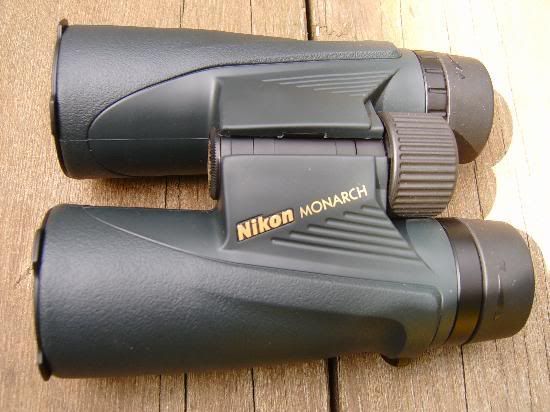
Although I have quite a few binoculars in my safe, I don’t have nearly as many of them as I do flashlights (most of you know me as the crazy guy that owns all those flashlights); but fear not, I am getting there.
So it occurred to me that I should make a post about binoculars for those that are bored of hearing about my lights.
I had owned quite a good amount of binoculars since I bought my first as a 15 year-old with an itch about optics. I even owned an expensive Zeiss when I was single and didn’t had a family to take care of.
And I am here to tell you that the quality, brightness, sharpness, and durability of the new binoculars now on the market; it is better than ever.
Not long ago, if we wanted all these features in a good binocular the choice was between spending a thousand in a Zeiss, Swarosvki, Leica or Minox or looking for good Porro prisms in the Nikon or Pentax lines.
But since a couple of years ago, the Japanese starting coating the roof prisms of their binoculars with Phase Coating, and the sharpness and definition of their roof prism binos had increased to the point to rival the European imports from the big four, and all at very modest cost.
Take, for example, the Nikon Monarch ATB (All terrain binocular) 8x42 I just received, or my Pentax DCF WP 8x42 that I bought last year.
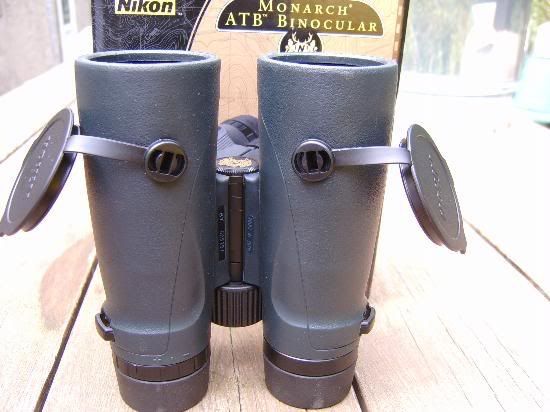
All lenses are fully multicoated (that means all surfaces, not only the glass to air surfaces) prisms are phased-corrected and have mirror-coated lower prisms (not cheap aluminum). They have blackened tubes to avoid reflections and are waterproof and fog proof; they have a nice outer coating of rubber (silent) and very good ergonomics. I particularly like the twist eye cups for eye-glass wearers and the ample eye relief: no problem using it with my glasses and instant acquisition of the picture even with glasses on.
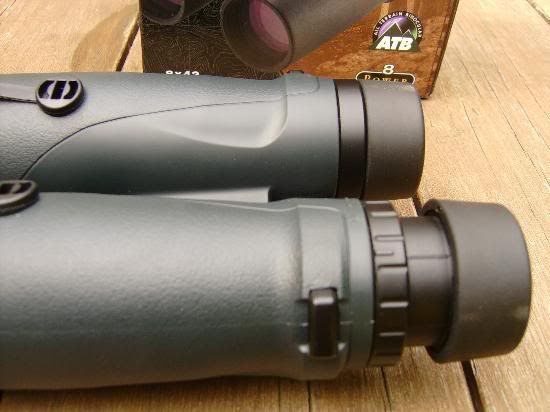
All that can be said for the Nikon Monarch can be said also of my Pentax DCF WP 8x42, except for the weight: the Nikon is lighter at 22 ounces but I don’t know how much my Pentax weighs until I get a new battery for my fish scale.
I like the approach of securing the objective caps to the body of the binocular that the Nikon uses as well. I had to get creative with the Pentax and cook up something home-made to hold the caps to the binocular body.
I did the usual checking for good prisms by holding the binos a few inches away and looking at the light spot in the ocular lens, nice and round without any hint of flattening, just like I was expecting. I checked collimation by holding it a few inches away and pointing them at the yellow line in the road, straight and sharp with not sign of being distorted.
To test the sharpness and resolution most people look from the inside to the outside thru an open window, and most binoculars will perform well under those conditions. I look for a dark corner in the room and try to read some labels or a newspaper print set for the occasion; that is what separates the mediocre from the good or great binoculars.
As the Nikon and the Pentax are so the same in quality I tried to spot any optical differences between them by perching one on top of the other and alternatively looking thru them. After several minutes of this I have to admit that they are both the same optical quality as far as my eyes can tell, without resorting to an optical laboratory.
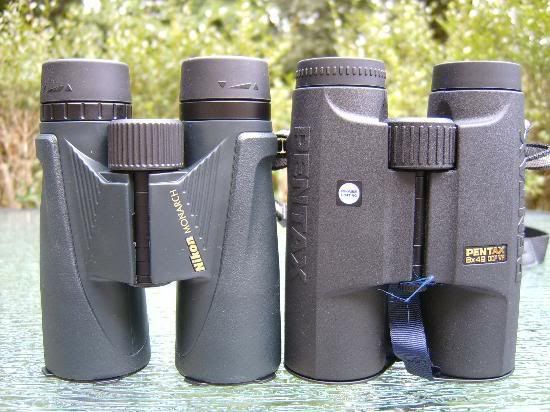
I have looked thru many Swarovski and Zeiss lenses, (I hunt the stores) superb optical quality in those glasses. I can tell you for sure than the new Nikon and Pentax are almost the equal of those expensive brands; that I only paid just over $300 with shipping for such a superb glass as the Nikon still amazes me.
Kind regards,
Watchmaker
Hi guys,
The big brown truck and the nice man that brings goodies to the house stopped yesterday with a package from Cabela’s.
I was deprived from sleep for the five days that it took between order and delivery, but finally the Nikon Monarch ATB 8x40 binoculars are here, and I will sleep soundly tonight.

Although I have quite a few binoculars in my safe, I don’t have nearly as many of them as I do flashlights (most of you know me as the crazy guy that owns all those flashlights); but fear not, I am getting there.
So it occurred to me that I should make a post about binoculars for those that are bored of hearing about my lights.
I had owned quite a good amount of binoculars since I bought my first as a 15 year-old with an itch about optics. I even owned an expensive Zeiss when I was single and didn’t had a family to take care of.
And I am here to tell you that the quality, brightness, sharpness, and durability of the new binoculars now on the market; it is better than ever.
Not long ago, if we wanted all these features in a good binocular the choice was between spending a thousand in a Zeiss, Swarosvki, Leica or Minox or looking for good Porro prisms in the Nikon or Pentax lines.
But since a couple of years ago, the Japanese starting coating the roof prisms of their binoculars with Phase Coating, and the sharpness and definition of their roof prism binos had increased to the point to rival the European imports from the big four, and all at very modest cost.
Take, for example, the Nikon Monarch ATB (All terrain binocular) 8x42 I just received, or my Pentax DCF WP 8x42 that I bought last year.

All lenses are fully multicoated (that means all surfaces, not only the glass to air surfaces) prisms are phased-corrected and have mirror-coated lower prisms (not cheap aluminum). They have blackened tubes to avoid reflections and are waterproof and fog proof; they have a nice outer coating of rubber (silent) and very good ergonomics. I particularly like the twist eye cups for eye-glass wearers and the ample eye relief: no problem using it with my glasses and instant acquisition of the picture even with glasses on.

All that can be said for the Nikon Monarch can be said also of my Pentax DCF WP 8x42, except for the weight: the Nikon is lighter at 22 ounces but I don’t know how much my Pentax weighs until I get a new battery for my fish scale.
I like the approach of securing the objective caps to the body of the binocular that the Nikon uses as well. I had to get creative with the Pentax and cook up something home-made to hold the caps to the binocular body.
I did the usual checking for good prisms by holding the binos a few inches away and looking at the light spot in the ocular lens, nice and round without any hint of flattening, just like I was expecting. I checked collimation by holding it a few inches away and pointing them at the yellow line in the road, straight and sharp with not sign of being distorted.
To test the sharpness and resolution most people look from the inside to the outside thru an open window, and most binoculars will perform well under those conditions. I look for a dark corner in the room and try to read some labels or a newspaper print set for the occasion; that is what separates the mediocre from the good or great binoculars.
As the Nikon and the Pentax are so the same in quality I tried to spot any optical differences between them by perching one on top of the other and alternatively looking thru them. After several minutes of this I have to admit that they are both the same optical quality as far as my eyes can tell, without resorting to an optical laboratory.

I have looked thru many Swarovski and Zeiss lenses, (I hunt the stores) superb optical quality in those glasses. I can tell you for sure than the new Nikon and Pentax are almost the equal of those expensive brands; that I only paid just over $300 with shipping for such a superb glass as the Nikon still amazes me.
Kind regards,
Watchmaker
-
watchmaker
- Spike

- Posts: 99
- Joined: Fri Aug 10, 2007 8:11 pm
- Location: New York
BINOCULARS 8 X 56
Hi guys,
This post will be of little help to those looking to buy a binocular in the 8 x 56 size, because what I have here is a little outdated, my Tasco 8x56 is about twenty seven years old and my Pentax DCF 8x56 about six.
Still let me talk a little about them so you can see what job the monster can do.
Great improvement has been made lately, especially in the phase correction of prisms that has sharpened the image considerably.
These big and heavy binoculars together with the 7x50 are called night glasses and they have a very specialized job of taking advantage of the last available light at dusk and before dawn to see game in their habitat, they are mostly used by European hunters with their liberal shooting hours and used mostly from machans or hotchsit where the bulk and weight are of no consequence.
In the eighties I was involved in doing some research in the habits of black bear, I have seated many times at bait stations armed only with these heavy binoculars, learning the feeding peculiarities and the pecking order of the American black bear.
Although I had lusted over getting a Zeiss 8x56 I had to conform myself with the Tasco 8x56 for many years until I found a brighter binocular in the Pentax DCF.
Brightness is a function of many things (including the objective diameter) the more prominent of them is quality of glass, the better factories use heavy and expensive Bak4 glass in the prisms and extra low dispersion glass for color correction and aspherical lenses that have multicoats of anti reflection coating as much as seven times; it looks like the Pentax binocular uses several of the new techniques to be brighter and sharper than the Tasco 8x56.

Although my Pentax DCF is not corrected for phase distortion at the prisms, it is extremely sharp and bright; the new binoculars in the line of Nikon, Pentax, and others are, being made even better by the addition of phase correction in the prisms.
In my Pentax the correction for eye relief for eye glass wearers is made on the old style fold down rubber eyecups, so you get only fully retracted or fully extended eye cups. I am very impressed with the new system in the Nikon line of helical retracted eye cups and in the Pentax line with the pull up or down eyecups that have come out in the last few years.
My six years old Pentax DCF 8x56 has the objective and ocular caps not attached in any way to the body of the binocular, I had to get creative and cook something home made with a ribbon and some Velcro to have those caps at all times together with the binoculars, new binoculars in the Pentax line will be better in this regard (at least they have a solid ocular lens cover) and I am impressed with the system of retaining the covers that Nikon is using now.
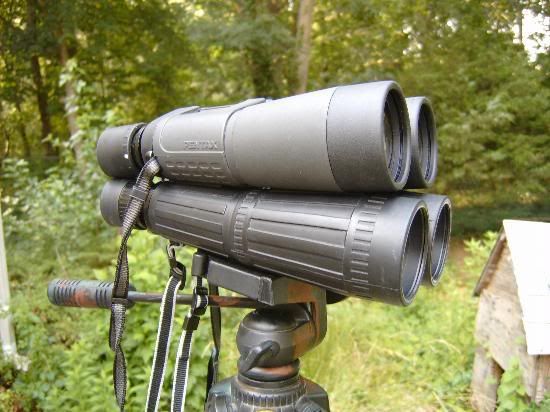
I pulled both binoculars from the safe a few days ago and compared the brightness and sharpness by putting them in the tripod perched in top of each other and taking alternate peeks throughout them at a ADT sign that is in my neighbor house, located at 50 yards from the tripod (by laser rangefinder) it reads in very small letter “protected by” ADT in big letters and again in small letters “security systems”.
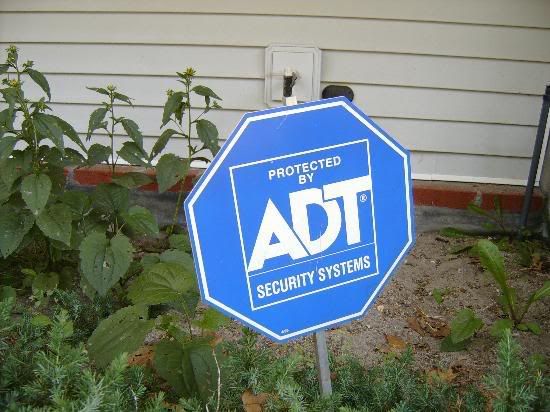
Both binocular let me read the sign and the small letters, but the Pentax was sharper than the Tasco and the quality of glass on the Pentax resolved much better when the light was falling down.
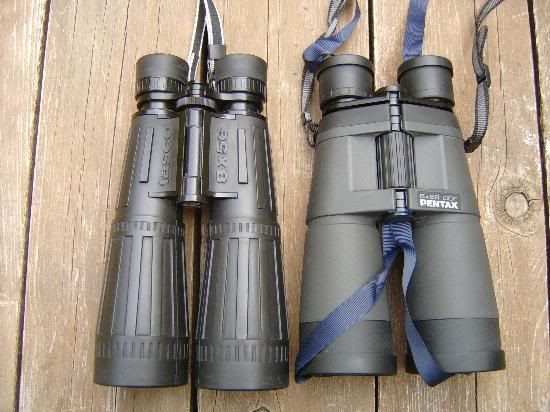
At dusk when other binocular have quit, the big 8x56 continues to show you a clear picture. As I see its utility is for those that are willing to carry them in a back pack to use only after the daylight binoculars carried in the neck have quit showing detail.
I don’t think many of these big 8x56 are sold, many people from hunters to bird watchers prefer top carry the compacts 8x42 that are lighter and less bulky and can show birds or game quite well until just before dusk, still I am writing this so everybody is aware that they exist and that they perform a very special function.
Kind regards
Watchmaker
Hi guys,
This post will be of little help to those looking to buy a binocular in the 8 x 56 size, because what I have here is a little outdated, my Tasco 8x56 is about twenty seven years old and my Pentax DCF 8x56 about six.
Still let me talk a little about them so you can see what job the monster can do.
Great improvement has been made lately, especially in the phase correction of prisms that has sharpened the image considerably.
These big and heavy binoculars together with the 7x50 are called night glasses and they have a very specialized job of taking advantage of the last available light at dusk and before dawn to see game in their habitat, they are mostly used by European hunters with their liberal shooting hours and used mostly from machans or hotchsit where the bulk and weight are of no consequence.
In the eighties I was involved in doing some research in the habits of black bear, I have seated many times at bait stations armed only with these heavy binoculars, learning the feeding peculiarities and the pecking order of the American black bear.
Although I had lusted over getting a Zeiss 8x56 I had to conform myself with the Tasco 8x56 for many years until I found a brighter binocular in the Pentax DCF.
Brightness is a function of many things (including the objective diameter) the more prominent of them is quality of glass, the better factories use heavy and expensive Bak4 glass in the prisms and extra low dispersion glass for color correction and aspherical lenses that have multicoats of anti reflection coating as much as seven times; it looks like the Pentax binocular uses several of the new techniques to be brighter and sharper than the Tasco 8x56.

Although my Pentax DCF is not corrected for phase distortion at the prisms, it is extremely sharp and bright; the new binoculars in the line of Nikon, Pentax, and others are, being made even better by the addition of phase correction in the prisms.
In my Pentax the correction for eye relief for eye glass wearers is made on the old style fold down rubber eyecups, so you get only fully retracted or fully extended eye cups. I am very impressed with the new system in the Nikon line of helical retracted eye cups and in the Pentax line with the pull up or down eyecups that have come out in the last few years.
My six years old Pentax DCF 8x56 has the objective and ocular caps not attached in any way to the body of the binocular, I had to get creative and cook something home made with a ribbon and some Velcro to have those caps at all times together with the binoculars, new binoculars in the Pentax line will be better in this regard (at least they have a solid ocular lens cover) and I am impressed with the system of retaining the covers that Nikon is using now.

I pulled both binoculars from the safe a few days ago and compared the brightness and sharpness by putting them in the tripod perched in top of each other and taking alternate peeks throughout them at a ADT sign that is in my neighbor house, located at 50 yards from the tripod (by laser rangefinder) it reads in very small letter “protected by” ADT in big letters and again in small letters “security systems”.

Both binocular let me read the sign and the small letters, but the Pentax was sharper than the Tasco and the quality of glass on the Pentax resolved much better when the light was falling down.

At dusk when other binocular have quit, the big 8x56 continues to show you a clear picture. As I see its utility is for those that are willing to carry them in a back pack to use only after the daylight binoculars carried in the neck have quit showing detail.
I don’t think many of these big 8x56 are sold, many people from hunters to bird watchers prefer top carry the compacts 8x42 that are lighter and less bulky and can show birds or game quite well until just before dusk, still I am writing this so everybody is aware that they exist and that they perform a very special function.
Kind regards
Watchmaker
-
TheGreatwhitehunter
- Moderator

- Posts: 2117
- Joined: Sun Jul 09, 2006 1:00 am
- Location: COLORADO
- MuleyMadness
- Site Admin

- Posts: 9997
- Joined: Thu Oct 10, 2002 9:34 pm
- Location: St. George, UT
- Contact:
-
OHIOFLATLANDER
- Spike

- Posts: 58
- Joined: Tue Aug 29, 2006 8:59 am
- Location: Medina Ohio
-
MuliesnMerriams
- 2 point

- Posts: 226
- Joined: Sun Jan 22, 2006 10:42 am
- Location: AZ
I've had a pair of Nikon 10x 42 Monarchs for 2 or 3 years now - no problems, love them. I lent them to a friend and they ended up getting a chip in one of the lenses .. But It didn't affect the view at all... As for the doubler - I haven't heard of one, and I looked on the Nikon website, and if they do make one I couldn't find any information on one...
-
watchmaker
- Spike

- Posts: 99
- Joined: Fri Aug 10, 2007 8:11 pm
- Location: New York
HOW TO GLASS
Well, what now, you just put he binoculars to your eyes and look through them, right?
Just in case we have new binocular users here, I am going to explain the mechanics of glassing the right way. Not long ago a new hunter in the family was showing me his new binoculars that I noticed were adjusted in the interpupilary distance with a far greater length that I knew his eyes to be set.
When I questioned him if he was not seeing two uncompleted circles when looking through the glasses, he admitted it and was surprised when I told him that the binoculars are supposed to deliver only one circle. I guess he has seen too many movies where the view trough binoculars are shown that way.
So our first business with the binoc is to adjust the interpupilary distance by bending the barrels at the center hinge until our eyes see only one circle; that will ensure that the optical center of the glasses is in line with the center of our pupils.
Second is to adjust the diopter wheel that is usually in the right barrel; as not everybody has 20/20 vision, this wheel will adjust the focus for your right eye. To accomplish the adjustment cover the right objective with your hand or objective cap, look through the glasses and adjust the center wheel until the view is sharp and clear, now cover the left objective and adjust the diopter wheel until the view is sharp.
I used for years to do this in the reverse sequence, adjusting the diopter first and then the center wheel, you get the same results.
Look at the markings at the edge of the wheel to remember the settings in case somebody changes them, (I just put a small drop of white out correction fluid to mark the setting).
The eye relief is fixed and in modern binoculars quite generous, but the eye cups collapse to use the binoculars with your eye glasses, some models can be adjusted to stop midway or at increments so you can get your oculars lenses as far or as close as you want to your eye glasses.
Now you are ready to glass, if yours glasses are 10x they are marginal in how steady you can hold them, people varies but 10x is the magnification that can do with some serious help in holding the glasses.
Sit down and brace your elbows against your knees or sunk them into your stomach looking for the best stable position, grasp you binos with both hands but leave your index fingers free and anchor them against your temples, or alternatively grasp the edge of your cap’s bill to add another anchor point. What you are looking for is to minimize or cancel any tremors, as a jumping up and down picture magnified 10x will not let you appreciate the detail that you bought the glasses for.
With the 8x you have a little more freedom from those tremors, I have a very steady hand (I am a watchmaker) and can hold 8x glasses with one hand for relatively quick looks, but it is not recommended, after all glasses are not for quick looks.
Don’t scan with glasses, your vision should be concentrated in the center of your view, and the glasses when moving, should be moving in very small increments when you are sure that the picture that you are seeing is completely understood by your brain.
The part of the eye that does the stationary looking and captures detail is very small; it is called the macula and covers only two degrees of your vision. When looking through 8x glasses this angle decrease to ¼ of a degree, so if you want to capture the detail that you pay so much money for, keep your glasses steady and look through the center of them.
The crouch and the belly down position are also glassing positions that should be not overlooked, take a tip from African hunters and steady your glasses in the standing position with the aid of a mono pod or shooting sticks or even a walking stick.
In carrying your glasses you can do as the African white hunters do and use a long strap to place them out of the way in the left side of your body at waist level and under your arm, or hang them from your neck but with a very short strap, so they ride high on your chest and will not swing and strike another object when you bend down.
There are in the market some harnesses that will keep your binoculars close to your body when you move around, but they usually interfere with other equipment, at least in my case as I wear a back pack most of the time but for those that carry only the glasses those harnesses work well.
All the best
Watchmaker
Well, what now, you just put he binoculars to your eyes and look through them, right?
Just in case we have new binocular users here, I am going to explain the mechanics of glassing the right way. Not long ago a new hunter in the family was showing me his new binoculars that I noticed were adjusted in the interpupilary distance with a far greater length that I knew his eyes to be set.
When I questioned him if he was not seeing two uncompleted circles when looking through the glasses, he admitted it and was surprised when I told him that the binoculars are supposed to deliver only one circle. I guess he has seen too many movies where the view trough binoculars are shown that way.
So our first business with the binoc is to adjust the interpupilary distance by bending the barrels at the center hinge until our eyes see only one circle; that will ensure that the optical center of the glasses is in line with the center of our pupils.
Second is to adjust the diopter wheel that is usually in the right barrel; as not everybody has 20/20 vision, this wheel will adjust the focus for your right eye. To accomplish the adjustment cover the right objective with your hand or objective cap, look through the glasses and adjust the center wheel until the view is sharp and clear, now cover the left objective and adjust the diopter wheel until the view is sharp.
I used for years to do this in the reverse sequence, adjusting the diopter first and then the center wheel, you get the same results.
Look at the markings at the edge of the wheel to remember the settings in case somebody changes them, (I just put a small drop of white out correction fluid to mark the setting).
The eye relief is fixed and in modern binoculars quite generous, but the eye cups collapse to use the binoculars with your eye glasses, some models can be adjusted to stop midway or at increments so you can get your oculars lenses as far or as close as you want to your eye glasses.
Now you are ready to glass, if yours glasses are 10x they are marginal in how steady you can hold them, people varies but 10x is the magnification that can do with some serious help in holding the glasses.
Sit down and brace your elbows against your knees or sunk them into your stomach looking for the best stable position, grasp you binos with both hands but leave your index fingers free and anchor them against your temples, or alternatively grasp the edge of your cap’s bill to add another anchor point. What you are looking for is to minimize or cancel any tremors, as a jumping up and down picture magnified 10x will not let you appreciate the detail that you bought the glasses for.
With the 8x you have a little more freedom from those tremors, I have a very steady hand (I am a watchmaker) and can hold 8x glasses with one hand for relatively quick looks, but it is not recommended, after all glasses are not for quick looks.
Don’t scan with glasses, your vision should be concentrated in the center of your view, and the glasses when moving, should be moving in very small increments when you are sure that the picture that you are seeing is completely understood by your brain.
The part of the eye that does the stationary looking and captures detail is very small; it is called the macula and covers only two degrees of your vision. When looking through 8x glasses this angle decrease to ¼ of a degree, so if you want to capture the detail that you pay so much money for, keep your glasses steady and look through the center of them.
The crouch and the belly down position are also glassing positions that should be not overlooked, take a tip from African hunters and steady your glasses in the standing position with the aid of a mono pod or shooting sticks or even a walking stick.
In carrying your glasses you can do as the African white hunters do and use a long strap to place them out of the way in the left side of your body at waist level and under your arm, or hang them from your neck but with a very short strap, so they ride high on your chest and will not swing and strike another object when you bend down.
There are in the market some harnesses that will keep your binoculars close to your body when you move around, but they usually interfere with other equipment, at least in my case as I wear a back pack most of the time but for those that carry only the glasses those harnesses work well.
All the best
Watchmaker
-
watchmaker
- Spike

- Posts: 99
- Joined: Fri Aug 10, 2007 8:11 pm
- Location: New York
Thank you for your appreciation of the post Brett.MuleyMadness wrote:Watchmaker
Very good information and very informative review.
Tell us more about yourself and what you do for work, is reviewing
products part of your job?
Thanks
Brett
I retired from watchmaking and have more time to play with my toys, I am not a proffesional reviewer, just a guy with an optic and light itch.
I like to hunt with the bow near home, here in the Island, and with the rifle in Adirondacks, getting more involved now in traditional black powder shooting. I collect knives, lights and others toys, but I am slowing down now.
For hobby I do the Borealis flashlight for friends and police officers, here in my neck of the woods.
I like to hunt in Maine for bear, and I suppose to plan a Mule deer and Elk hunt, but my son entered College last week and I will be poor a while longer.
That is all guys,
All the best
Watchmaker
-
watchmaker
- Spike

- Posts: 99
- Joined: Fri Aug 10, 2007 8:11 pm
- Location: New York
LEUPOLD YOSEMITE 6X 30MM
PORRO PRISMS BINOCULARS
Hi Guys:
Some things are changing in the world of optics. It uses to be that you had to spend a good chunk of money to get good optics; after all, it is difficult and requires expensive lenses, expensive anti-reflection treatment, some quality components, and precise work to mount it all and to get the optics to perform as they should.
Some optical aberrations and distortions can only be corrected the best possible. It is difficult to make good glasses to deliver a flat picture of good quality when the light ray has to pass through curved lenses.
But the new computerized optics programs than the optical engineer is using these days has brought a solution to the trial-and-error and time-consuming work that was needed to produce decent binocular blueprints in the old days.
They are several factors, beside objective size, that will determine how good the image quality in binoculars will be.
They include optical coating, quality of optics, distortions and aberrations, optical alignment, and manufacturer tolerances.
THE LEUPOLD 6X30MM YOSEMITE
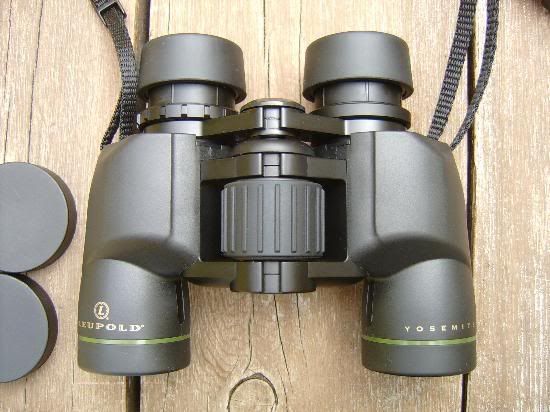
Back in 1970, I came back from the jungles of South America in one piece, but minus my good Zeiss binoculars. In seventy-one, freshly married and planning a trip, I was in need of a binocular, but my budget was $25.00 (you bought a lot of gasoline with $25 in the seventies).
After looking at several on that price range, I selected a 7x35 Porro prisms Sunset (Japanese). It says in big white letters that it is an extra-wide angle (10 degrees), which, at the time, didn’t affect me since my young eyes in those days didn’t need prescription glasses (wide angle will reduce the eye relief, an important consideration to eyeglass wearers). But poor eye relief means that you have to get your eye very close to the lens to see the whole picture, which can put a drop of perspiration on the glass in hot days or fog them in the cold climate.
It also makes it impossible to focus the edges of the glass. The center will be in focus, but the edges will be blurry: this distortion is called “curvature of field,” so keep in mind to stay away from wide field-of-view glasses if you want your picture to be relatively sharp all around.
It also says that it has coated optics, which means (and I can see it) that only the exterior lenses have been coated on the outside, and that translates that a good amount of light is going to be lost throughout reflection, making them inferior to glasses that used multi-coating lenses to see in deep shadows and at dusk .
LEUPOLD YOSEMITE AND SUNSET BINOCULARS
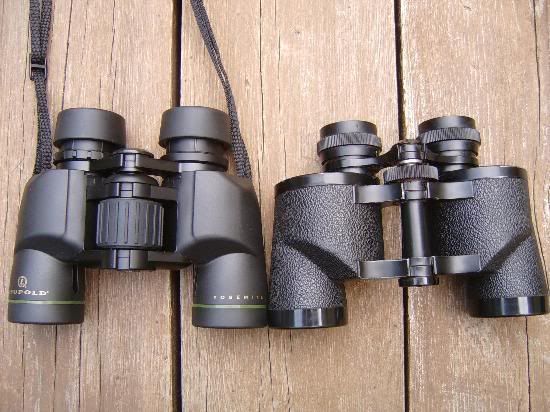
So brightness and sharpness are affected by the amount and quality of the coating that are used in binoculars- the more the better (as much as seven coats for glass surfaces are been used now). When you think that as much as 4 % of light is lost through reflection from uncoated surfaces and that a binocular uses a total of 14 or more optical glass inside them, you will understand why multi-coats are so important for light transmission.
YOU CAN SEE THE DIFFERENCE IN THE COATING BETWEEN THEM
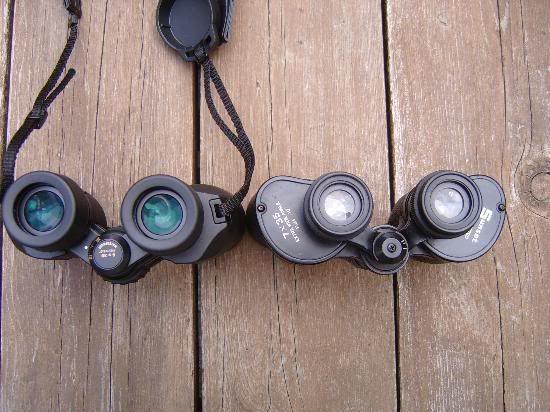
I can see that the lenses in the Sunset haven’t been corrected for chromatic aberrations, which means that the colors will be more muddled if I were looking at birds. Of course, correcting for color needs a set of different glass, all keyed to a certain spectrum on the color scale, which makes binoculars more expensive and will have taken me out of my $25.00 budget in those days.
Be careful of cheap binoculars with big lenses (50 to 60 or more mm of objective), as the bigger the lenses are, the more intense the chromatic aberration will be, unless it is corrected by low dispersion glass that will make the binoculars much more expensive.
Good glasses should be corrected for another aberration called “astigmatism,” which is the effect of the light at the edges of the glass that is elongated into an oval that points toward the center. This together with the “curvature of field” tends to make glasses fuzzy toward the edges. I believe my Sunset 7x35 glasses shows a good degree of astigmatism.
Of course, my 38 year-old glasses also show a good deal of spherical aberration. There is no way that ray of light passing trough the center of a normal glass can be in the same focus as the ones passing through the edges. This makes the image loss detail. Newer binoculars are now using an aspheric lens (usually in the oculars) that corrects the focus by bringing the center light rays to the same focus as edges rays of light, making the glass brightest and with increased contrast.
My Sunset glasses show some “barrel distortion.” Were a straight line placed on the edge of the field of view, it will bow outwards at the center. If that line will bow inwards at the center, it will be called “pin cushion distortion.” Good glasses correct for this distortion with quality glass, although you can still find just a little of it even in expensive glasses.
AT LEFT IS A REGULAR OPTICAL GLASS WITH CURVED SURFACES, AT RIGHT IS THE NEW AESPHERICAL LENS
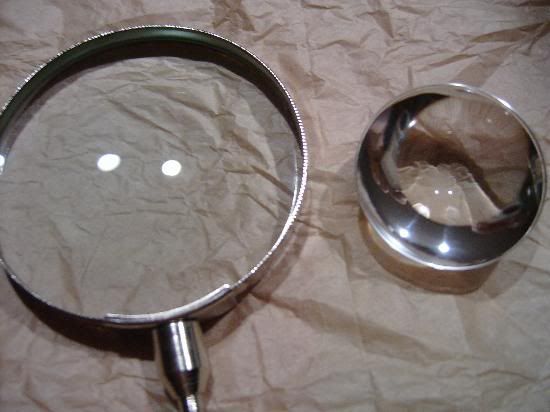
My Sunset 7x35 binoculars did fine for a few years (I didn’t use them much in low light) until I replaced them in my neck for a Bushnell Custom Compact 6x 25 CF in 1974, which then started my love affair with 6x lenses.
The Bushnell Custom Compact are beautiful binoculars; light, small, and highly good optics that still sells today and is highly sought after by those that don’t want to carry full binoculars when birding or hunting.
The street price on the Custom Compact is around $250.00, and it is well worth it. I have used mine for years in hikes into the high peaks of the Adirondacks. I think so highly of them that I had bought a pair for my wife in 1976.
The only thing I always wondered was how it would perform in poor light if the objectives were as big as 30 mm instead of 25mm.
Now, after so many years, another 6x binocular has fallen into my hands, thanks to the advice of FirstFreedom, a member of TFL forum.
The Leupold Yosemite Porro prisms 6x30 is in my hands now and a beauty it is, both physically and optically.
This Leupold is miles ahead of my Sunset 7x35, the comparisons I made in low light gives a great edge to the Leupold even than the objectives are 5mm smaller in the Leupold, and the numbers for exit pupil gives both the same 5mm value (35 mm divided by 7x = 5mm and 30 mm divided by 6x = 5mm of exit pupil). The Leupold outperforms my Sunset glasses, due to better coating and better optics.
I was surprised when I put both in my fish scale because both weigh 1 lb. 1 oz., but the Leupold feels much lighter. The rubber covering and the twist up eye-piece guards are a big asset for the Leupold, as the Sunset doesn’t have any eye-piece guards at all. The Leupold Yosemite comes with a rain guard that is tethered to the elastic strap and regular caps in the objectives. That is one thing I would like to see changed; objectives should be protected with covers, such as the ones find in my Nikon Monarch, that are attached to the binocular body and not by caps that are easily lost.
Optically, the Leupold Yosemite is very superior to the Sunset glass. Some aberrations and distortions are still in the glasses, but only in a reduced amount and in the edge of the field of view, and it is okay, because only very high quality glasses like the Swarovski and Zeiss can make those defects disappear almost completely, and after all, most of us look through the center of the field anyway, and not through the edges.
Color seems to be fully corrected in the Yosemite, although I have yet to find a proper test medium to judge it (hummingbirds or woodpeckers).
Sharpness and definition are well up in the scale, leaving the Sunset glasses in the dust. That all this optical quality is attained at the cost of only less than a hundred USD is a miracle of new manufacturing techniques. I am well pleased with the new Yosemite binoculars by Leupold, I took a calculated risk when I bought them, based on the Leupold name in others optics and I am well satisfied with what I got and for the little money I got them.
Best wishes
Watchmaker
PORRO PRISMS BINOCULARS
Hi Guys:
Some things are changing in the world of optics. It uses to be that you had to spend a good chunk of money to get good optics; after all, it is difficult and requires expensive lenses, expensive anti-reflection treatment, some quality components, and precise work to mount it all and to get the optics to perform as they should.
Some optical aberrations and distortions can only be corrected the best possible. It is difficult to make good glasses to deliver a flat picture of good quality when the light ray has to pass through curved lenses.
But the new computerized optics programs than the optical engineer is using these days has brought a solution to the trial-and-error and time-consuming work that was needed to produce decent binocular blueprints in the old days.
They are several factors, beside objective size, that will determine how good the image quality in binoculars will be.
They include optical coating, quality of optics, distortions and aberrations, optical alignment, and manufacturer tolerances.
THE LEUPOLD 6X30MM YOSEMITE

Back in 1970, I came back from the jungles of South America in one piece, but minus my good Zeiss binoculars. In seventy-one, freshly married and planning a trip, I was in need of a binocular, but my budget was $25.00 (you bought a lot of gasoline with $25 in the seventies).
After looking at several on that price range, I selected a 7x35 Porro prisms Sunset (Japanese). It says in big white letters that it is an extra-wide angle (10 degrees), which, at the time, didn’t affect me since my young eyes in those days didn’t need prescription glasses (wide angle will reduce the eye relief, an important consideration to eyeglass wearers). But poor eye relief means that you have to get your eye very close to the lens to see the whole picture, which can put a drop of perspiration on the glass in hot days or fog them in the cold climate.
It also makes it impossible to focus the edges of the glass. The center will be in focus, but the edges will be blurry: this distortion is called “curvature of field,” so keep in mind to stay away from wide field-of-view glasses if you want your picture to be relatively sharp all around.
It also says that it has coated optics, which means (and I can see it) that only the exterior lenses have been coated on the outside, and that translates that a good amount of light is going to be lost throughout reflection, making them inferior to glasses that used multi-coating lenses to see in deep shadows and at dusk .
LEUPOLD YOSEMITE AND SUNSET BINOCULARS

So brightness and sharpness are affected by the amount and quality of the coating that are used in binoculars- the more the better (as much as seven coats for glass surfaces are been used now). When you think that as much as 4 % of light is lost through reflection from uncoated surfaces and that a binocular uses a total of 14 or more optical glass inside them, you will understand why multi-coats are so important for light transmission.
YOU CAN SEE THE DIFFERENCE IN THE COATING BETWEEN THEM

I can see that the lenses in the Sunset haven’t been corrected for chromatic aberrations, which means that the colors will be more muddled if I were looking at birds. Of course, correcting for color needs a set of different glass, all keyed to a certain spectrum on the color scale, which makes binoculars more expensive and will have taken me out of my $25.00 budget in those days.
Be careful of cheap binoculars with big lenses (50 to 60 or more mm of objective), as the bigger the lenses are, the more intense the chromatic aberration will be, unless it is corrected by low dispersion glass that will make the binoculars much more expensive.
Good glasses should be corrected for another aberration called “astigmatism,” which is the effect of the light at the edges of the glass that is elongated into an oval that points toward the center. This together with the “curvature of field” tends to make glasses fuzzy toward the edges. I believe my Sunset 7x35 glasses shows a good degree of astigmatism.
Of course, my 38 year-old glasses also show a good deal of spherical aberration. There is no way that ray of light passing trough the center of a normal glass can be in the same focus as the ones passing through the edges. This makes the image loss detail. Newer binoculars are now using an aspheric lens (usually in the oculars) that corrects the focus by bringing the center light rays to the same focus as edges rays of light, making the glass brightest and with increased contrast.
My Sunset glasses show some “barrel distortion.” Were a straight line placed on the edge of the field of view, it will bow outwards at the center. If that line will bow inwards at the center, it will be called “pin cushion distortion.” Good glasses correct for this distortion with quality glass, although you can still find just a little of it even in expensive glasses.
AT LEFT IS A REGULAR OPTICAL GLASS WITH CURVED SURFACES, AT RIGHT IS THE NEW AESPHERICAL LENS

My Sunset 7x35 binoculars did fine for a few years (I didn’t use them much in low light) until I replaced them in my neck for a Bushnell Custom Compact 6x 25 CF in 1974, which then started my love affair with 6x lenses.
The Bushnell Custom Compact are beautiful binoculars; light, small, and highly good optics that still sells today and is highly sought after by those that don’t want to carry full binoculars when birding or hunting.
The street price on the Custom Compact is around $250.00, and it is well worth it. I have used mine for years in hikes into the high peaks of the Adirondacks. I think so highly of them that I had bought a pair for my wife in 1976.
The only thing I always wondered was how it would perform in poor light if the objectives were as big as 30 mm instead of 25mm.
Now, after so many years, another 6x binocular has fallen into my hands, thanks to the advice of FirstFreedom, a member of TFL forum.
The Leupold Yosemite Porro prisms 6x30 is in my hands now and a beauty it is, both physically and optically.
This Leupold is miles ahead of my Sunset 7x35, the comparisons I made in low light gives a great edge to the Leupold even than the objectives are 5mm smaller in the Leupold, and the numbers for exit pupil gives both the same 5mm value (35 mm divided by 7x = 5mm and 30 mm divided by 6x = 5mm of exit pupil). The Leupold outperforms my Sunset glasses, due to better coating and better optics.
I was surprised when I put both in my fish scale because both weigh 1 lb. 1 oz., but the Leupold feels much lighter. The rubber covering and the twist up eye-piece guards are a big asset for the Leupold, as the Sunset doesn’t have any eye-piece guards at all. The Leupold Yosemite comes with a rain guard that is tethered to the elastic strap and regular caps in the objectives. That is one thing I would like to see changed; objectives should be protected with covers, such as the ones find in my Nikon Monarch, that are attached to the binocular body and not by caps that are easily lost.
Optically, the Leupold Yosemite is very superior to the Sunset glass. Some aberrations and distortions are still in the glasses, but only in a reduced amount and in the edge of the field of view, and it is okay, because only very high quality glasses like the Swarovski and Zeiss can make those defects disappear almost completely, and after all, most of us look through the center of the field anyway, and not through the edges.
Color seems to be fully corrected in the Yosemite, although I have yet to find a proper test medium to judge it (hummingbirds or woodpeckers).
Sharpness and definition are well up in the scale, leaving the Sunset glasses in the dust. That all this optical quality is attained at the cost of only less than a hundred USD is a miracle of new manufacturing techniques. I am well pleased with the new Yosemite binoculars by Leupold, I took a calculated risk when I bought them, based on the Leupold name in others optics and I am well satisfied with what I got and for the little money I got them.
Best wishes
Watchmaker




